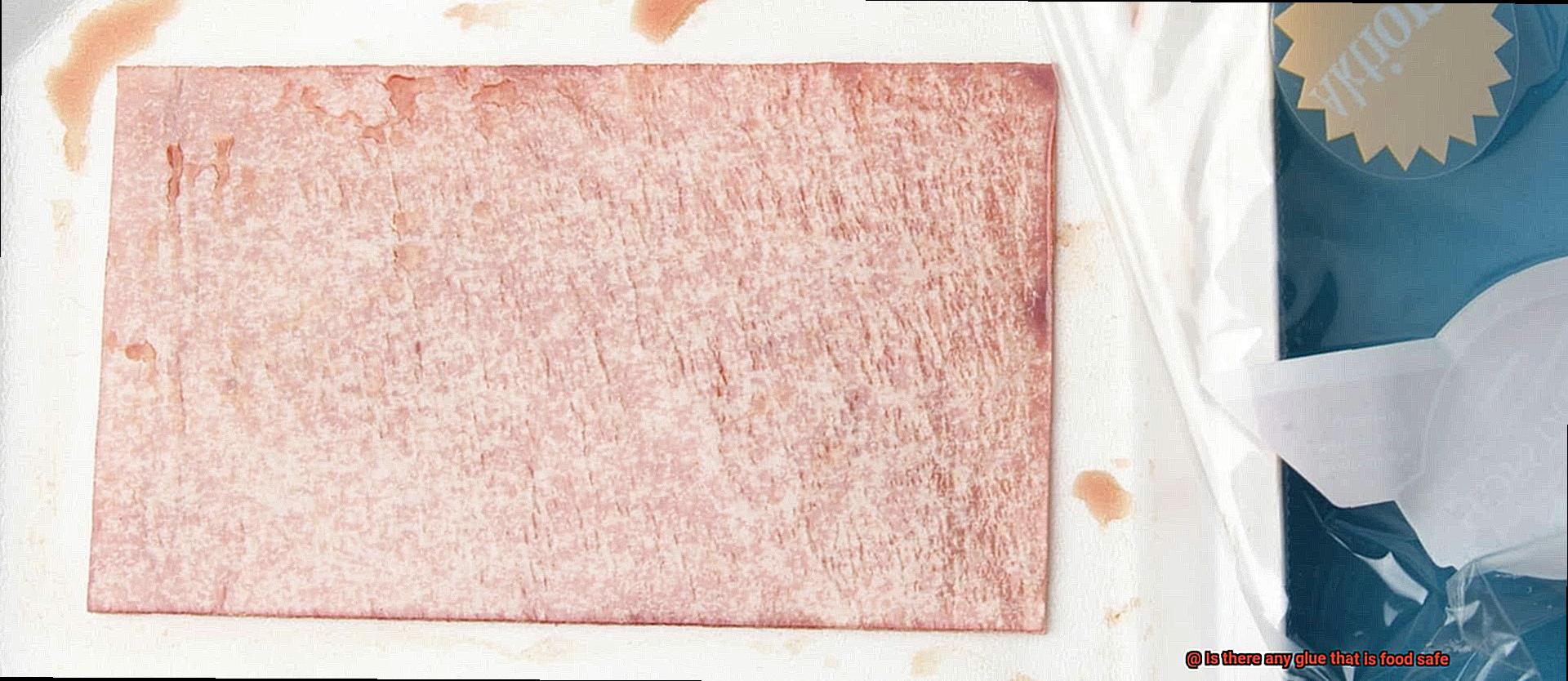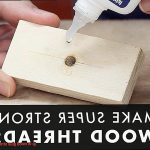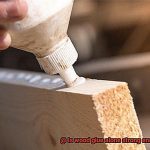Welcome to our blog post all about food-safe glues. Picture this: you’re in the kitchen, and your favorite mug has taken a tumble, shattering into a million pieces. Panic sets in as you wonder if it’s safe to glue it back together. Well, fear not. We’re here to answer that burning question: “Is there any glue that is safe to use with food?”
Lucky for us, the answer is a resounding yes. There are glues out there specifically made to be food safe. In this article, we’ll take a deep dive into the world of these magical adhesives. We’ll explore the different types available on the market and spill the beans on their pros and cons.
Whether you’re a DIY guru or simply someone who wants peace of mind when it comes to your kitchen tools, this information will be your secret weapon. So, buckle up and get ready to embark on an adventure through the realm of food-safe glues. Let’s get started.
Types of Food Safe Glue
Contents
- 1 Types of Food Safe Glue
- 2 Advantages of Using Food Safe Glue
- 3 How to Choose a Food Safe Glue
- 4 Considerations When Using Food Safe Glue
- 5 Common Uses for Food Safe Glue
- 6 How to Apply and Cure Food Safe Glue
- 7 Potential Health Risks from Non-Food Safe Glues
- 8 Tips for Working with Food Safe Glue
- 9 Conclusion
In this article, we will delve into the properties, applications, and limitations of various popular options, providing you with valuable insights and examples.
Epoxy Resin: Strength and Durability Unleashed
Epoxy resin stands as a versatile adhesive celebrated for its exceptional strength and durability. Its robust bonding capabilities make it a go-to choice for constructing cutting boards, countertops, and other kitchen utensils.
This type of glue creates a powerful bond between surfaces, ensuring safety even in direct contact with food. Resistant to water and chemicals, epoxy resin guarantees not only longevity but also a reliable safeguard for your kitchen items.
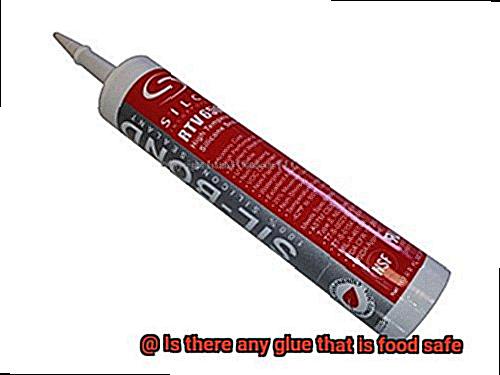
Cyanoacrylate Adhesive (Super Glue): Swift and Trustworthy Fixes
Cyanoacrylate adhesive, commonly known as super glue, emerges as a fast-acting adhesive that forms an unyielding bond between surfaces. Perfect for repairing or bonding delicate items such as ceramic or glass dishes in the culinary industry, super glue offers quick and reliable fixes. However, it’s crucial to check the product label before utilizing super glue in food-related applications, as not all variants are deemed food safe.
Food Grade Silicone Adhesive: Heat Resistance Meets Flexibility
Food grade silicone adhesive represents another exceptional option for food safe bonding. With its extraordinary flexibility and adhesion properties, this glue is designed to withstand high temperatures encountered in kitchen appliances like ovens and refrigerators. Moreover, it can be applied to seal gaps or joints in food containers or packaging, ensuring optimal safety and hygiene.
Glues Approved by Regulatory Bodies: Upholding Stringent Safety Standards
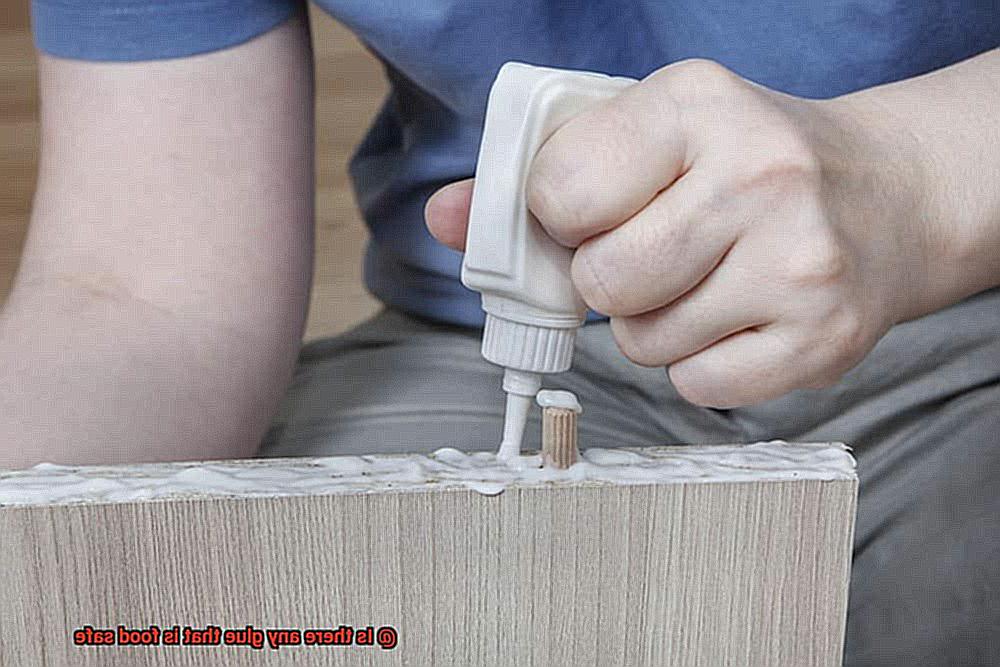
Certain glues have gained approval from regulatory bodies, undergoing rigorous testing to meet the safety standards required for direct or indirect contact with food. When purchasing glue for your kitchen projects, be on the lookout for products labeled as “food safe” or “FDA approved.” These glues can typically be found in specialty stores or online, providing peace of mind and reassurance in terms of safety.
Conclusion:
Choosing the right adhesive for your specific needs is vital when it comes to food safe glue. Epoxy resin, cyanoacrylate adhesive, food grade silicone adhesive, and glues approved by regulatory bodies all serve as excellent options. Remember to read product labels, adhere to proper application and curing procedures, and clean and sanitize bonded surfaces before using them for food preparation or consumption.
Advantages of Using Food Safe Glue
Look no further than the revolutionary solution: food safe glue. In this article, we will explore the numerous advantages of using food safe glue and how it can transform your culinary creations.
First and foremost, when it comes to anything that comes into contact with food, safety is paramount. Food safe glue is specifically formulated and rigorously tested to meet the stringent safety standards set for products in the food industry. With food safe glue, you can rest assured that no harmful chemicals or toxins will leach into your delectable dishes, ensuring the utmost health and well-being of your consumers.
But safety is just the beginning. The versatility offered by food safe glue is unparalleled. Whether you are a professional chef or a home baker, having access to a reliable food safe glue opens up a world of possibilities. From assembling intricate cake decorations to securing delicate fondant pieces, attaching edible glitter, or even joining different components of sugar sculptures, the applications are endless. Whatever your culinary vision may be, food safe glue can help bring it to life.
Convenience is another key advantage of using food safe glue. Traditional methods of assembly, such as toothpicks or relying solely on gravity, may not provide the desired stability or aesthetic appeal. Food safe glue offers a quick and efficient way to securely bond various components together without the need for additional supports or time-consuming techniques. This means less time spent worrying about structural integrity and more time focusing on creating stunning edible masterpieces.
In addition to convenience, food safe glue also offers exceptional longevity. While other adhesives may weaken or dissolve when exposed to moisture or high temperatures, food safe glue is specifically designed to withstand these conditions. This ensures that your edible creations remain intact and visually appealing for an extended period. Whether they are on display at an event or being transported, you can trust that your culinary works of art will maintain their integrity.
Last but not least, food safe glue is incredibly user-friendly. Most food safe glues come in convenient packaging, allowing for precise and controlled application. They often have a quick-drying formula, reducing the need for extended waiting time before handling or moving assembled food items. With its ease of use, food safe glue is accessible to both professionals and amateurs alike, empowering anyone to create stunning edible creations with confidence.
How to Choose a Food Safe Glue
When it comes to food-related projects, choosing the right glue is crucial to ensure the safety of your edibles. With so many options available, it can be overwhelming to find the perfect food safe glue for your needs. But fear not. In this article, we will break down the key factors to consider when selecting a food safe glue, ensuring that your creations stay secure and your meals stay delicious.
Factor 1: Look for the “Food Safe” Label
The first step in choosing a food safe glue is to look for products specifically labeled as “food safe” or “FDA approved.” These glues have undergone rigorous testing to ensure they are safe for direct contact with food. So keep an eye out for these trusty labels and rest easy knowing that your glue choice is up to par.
Factor 2: Check the Ingredients
To avoid any potential contamination, it’s essential to check the ingredients of the glue before making a purchase. Stay away from glues that contain harmful substances such as solvents, formaldehyde, or heavy metals. Opt for glues that boast non-toxic formulas and are free from any chemicals that could pose a risk to your health.
Factor 3: Consider Application Method
Glues come in various forms, so it’s important to choose one that suits your project. Some food safe glues come in tubes or bottles with nozzles for easy application, while others may require mixing or brushing onto surfaces. Consider the convenience factor and select a method that aligns with your specific project needs.
Factor 4: Read Reviews and Recommendations
When it comes to choosing a food safe glue, don’t just take our word for it. Read reviews and recommendations from others who have used the glue for similar purposes. Their experiences can provide valuable insights into the effectiveness and safety of the product. So, before you make a decision, take a quick look at what others have to say.
Factor 5: Quick Drying Time and Temperature Resistance
Nobody likes waiting around for glue to dry, especially when your meal is on the line. Opt for glues that offer quick drying times without compromising on bonding strength. Additionally, if you plan on using the glued item in high-temperature environments, such as an oven or microwave, ensure that the glue can withstand the heat without melting or releasing harmful fumes.
Factor 6: Longevity of the Bond
Think about the longevity of the bond you’re creating. If you want your glued item to last over time, especially when exposed to water or other liquids, choose a glue that offers a strong and durable bond. This way, you can enjoy your culinary creations without worrying about any unexpected mishaps.
Considerations When Using Food Safe Glue
When using food safe glue, there are several key considerations to keep in mind to ensure the safety and effectiveness of your culinary creations. First and foremost, it is crucial to read and follow the instructions provided by the manufacturer. These instructions contain valuable information on the proper usage and application techniques that will guarantee the glue is used safely.
Another important consideration is the type of material you are working with. Different glues are designed for specific materials, such as ceramics, glass, metal, or plastic. Choosing a glue that is compatible with the material you are working with is essential for achieving a strong and durable bond.
Temperature resistance is another critical factor to consider. If you plan on using the glued item in high-temperature environments, such as in an oven or microwave, it is crucial to select a glue that can withstand the heat. Nobody wants their hard work to turn into a melted mess.
The drying time of the glue is also an important consideration. Some glues require longer drying times, while others dry quickly. It is essential to allow sufficient drying time before using or handling the glued item to ensure that the bond is fully cured and secure.
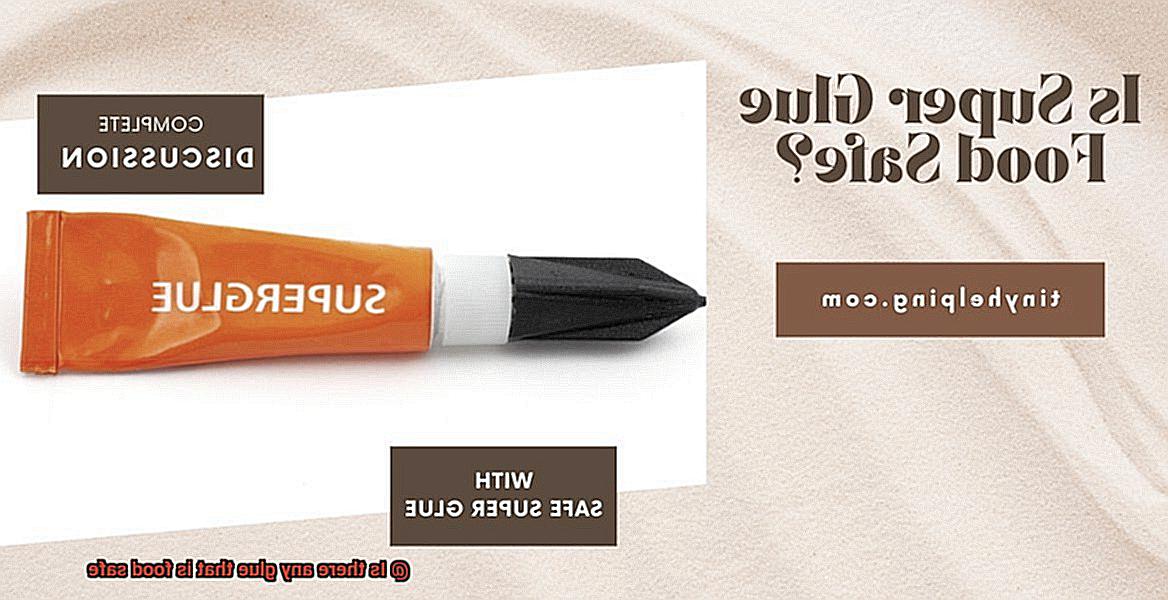
Moisture resistance is another key consideration when using food safe glue. If your glued item will come into contact with liquids or moisture, it is important to choose a glue that can withstand exposure to wetness. This will prevent your hard work from dissolving like sugar in hot tea.

While food safe glues are generally considered safe for use with food items, it is always wise to double-check for any specific warnings or precautions provided by the manufacturer. Additionally, when working with certain glues that may emit fumes, it is important to ensure that your creative space is well-ventilated.
Lastly, consider the other materials that may come into contact with your glued item. If you are repairing a ceramic plate, for example, make sure that any additional decorations or coatings used on the plate are also food safe and non-toxic. This will prevent any unwanted flavors from sneaking into your meals.
Common Uses for Food Safe Glue
Well, get ready to whip up a storm in the kitchen because today we’re diving into the world of food safe glue. Yes, you heard that right – glue isn’t just for arts and crafts anymore. In this post, we’ll explore the common uses for food safe glue in various industries and applications. So, grab your apron and let’s get started.
Packaging Industry:
Food safe glue plays a crucial role in sealing food containers like cans, jars, and bottles. It ensures that your favorite snacks and beverages are securely sealed and ready to be enjoyed. With its ability to withstand temperature changes and moisture exposure, this glue keeps your goodies fresh from production to your pantry.
Kitchen Utensils and Appliances:
Ever wondered how your trusty kitchen utensils and appliances stay intact? Well, food safe glue is the secret ingredient. When manufacturers assemble items like spatulas, knives, or blenders, they rely on food safe glue to bond different components together. This ensures that these tools are safe for use with food and won’t pose any health risks.
Furniture and Wooden Objects:
If you love hosting dinner parties or enjoy a good cheese platter, then you’ll appreciate the importance of food safe glue in furniture and wooden objects. Cutting boards, serving trays, and bowls all rely on this glue to secure their joints. The result? A sturdy and safe surface for all your delicious creations.
Catering Industry:
The catering industry is no stranger to the wonders of food safe glue. It can come to the rescue when a serving dish or utensil gets damaged – simply apply some glue and voila, good as new. Additionally, it can be used to create stunning decorative displays or arrangements for buffets or events. Get ready to wow your guests with your creative flair.
Arts and Crafts:
Calling all artists and crafters. Food safe glue is not only useful in the kitchen but also in the world of arts and crafts. It allows you to create unique pieces using materials that may come into contact with food or beverages. Imagine attaching decorations on cake stands or securing edible embellishments on cakes or cookies – the possibilities are endless.
Medical Field:
Last but not least, food safe glue has found its way into the medical field. It’s used for bonding medical devices or components that come into contact with bodily fluids or tissues during procedures or treatments. This ensures that these devices are safe for use and don’t pose any risks of contamination.
How to Apply and Cure Food Safe Glue
You may have wondered how to safely glue together food-related items without worrying about harmful chemicals. Well, fret no more. In this article, we will guide you through the process of applying and curing food safe glue, ensuring your creations are both delicious and secure.
Preparing the Surfaces:
Before diving into the gluing process, it’s crucial to clean the surfaces you’ll be bonding. Grab a mild detergent or rubbing alcohol and wipe away any grease, oil, or debris. Remember, cleanliness is the key to a strong bond. For an extra secure bond, lightly sand the surfaces with fine-grit sandpaper or a sanding block.
Applying the Glue:
Follow the instructions provided by the manufacturer carefully. Using a brush or applicator, apply a thin and even layer of food safe glue onto one of the surfaces. Avoid going overboard with the glue; just a touch will do. Remember, less is more when it comes to adhesive application.
Pressing It Together:
Now comes the fun part. Join the two surfaces together and press firmly. You can use clamps or weights to hold everything in place while the glue works its magic. Ensure good contact between the adhesive and materials by applying even pressure. This step is crucial for achieving a sturdy bond that will withstand the test of time.
Curing Time:
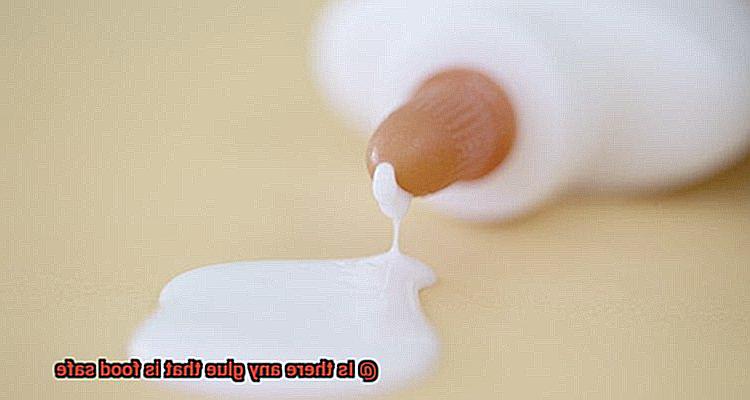
Patience is a virtue when it comes to gluing. Allow sufficient time for the glue to cure completely. The curing time varies depending on the glue type, so consult those trusty manufacturer instructions for guidance. Some food safe glues may require heat or moisture for proper curing, so be sure to follow any specific instructions provided.
Inspecting Your Creation:
Once your glue has cured, take a moment to inspect your handiwork. Check for any weak spots or incomplete areas. If needed, reapply the glue following the same steps mentioned above. It’s better to be safe than sorry, so make sure your creation is solid and secure before using it for food-related purposes.
Limitations and Safety Considerations:
While food safe glues are designed to be safe for use with food, it’s essential to understand their limitations. Always check product specifications and use the glue within recommended parameters. Remember, not all food safe glues can withstand high temperatures or dishwasher cycles. Additionally, avoid exposing food safe glue to harsh chemicals that may compromise its integrity.
Potential Health Risks from Non-Food Safe Glues
In this article, we will embark on a journey to uncover the hazards associated with these glues and explore why prioritizing glue safety is paramount when it comes to food.
The Dangers of Non-Food Safe Glues:
- Toxic Chemicals: Non-food safe glues, such as epoxy, super glue, and certain craft glues, harbor toxic chemicals like formaldehyde, toluene, and acetone. These chemicals have the potential to seep into food and pose grave health risks if ingested.
- Contamination: When non-food safe glues come into contact with food, the treacherous chemicals can transfer onto the food surface. Whether dishes or containers repaired with non-food safe glues are used to hold or serve food, contamination becomes an imminent threat.
- Health Issues: Ingesting food that has encountered non-food safe glues can lead to an array of health problems. From gastrointestinal woes to allergic reactions, and in severe cases, poisoning, these health issues cast a dark shadow over unsuspecting victims.
- Specific Risks: The specific health risks vary based on the type of glue and the chemicals it contains. Formaldehyde, a common ingredient in non-food safe glues, is a notorious carcinogen capable of triggering respiratory problems and irritating the skin.
Preventing Health Risks:
To minimize potential health risks from non-food safe glues, it is crucial to opt for food-safe alternatives when repairing or creating items that will come into contact with food. Here are some essential tips for ensuring glue safety:
- Choose Food-Safe Glues: Seek out products specifically labeled as food-safe or explicitly designed for use with food items. These glues are typically crafted from natural ingredients like starch or have received FDA approval for direct contact with food.
- Follow Instructions: Always adhere to the manufacturer’s instructions and allow sufficient drying time for the glue to fully cure before using the item with food. This ensures any potential residual chemicals have evaporated or become inert.
Tips for Working with Food Safe Glue
Working with food safe glue requires attention to detail and a commitment to maintaining the safety of your food and the strength of the bond. By following the tips and techniques outlined below, you can confidently use food safe glue for a variety of projects in your kitchen or restaurant. These guidelines will help ensure a successful and secure experience.
Choose Certified Food Safe Glue:
When selecting a food safe glue, look for products that are specifically labeled as safe for food contact. It is important to seek out glues that have been certified by regulatory agencies such as the FDA or EFSA, as this guarantees that the glue meets strict safety standards.
Follow Manufacturer’s Instructions:
To use food safe glue correctly and safely, carefully read and follow the instructions provided by the manufacturer. This will ensure that you achieve optimum results and avoid any potential risks.
Prepare Surfaces Properly:
Before applying food safe glue, thoroughly clean and prepare the surfaces you plan to bond. This step is crucial in creating a strong bond while preventing any contaminants from compromising the adhesive properties of the glue.
Use Appropriate Tools and Techniques:
Selecting the right tools, such as brushes, spatulas, or syringes, is essential for applying food safe glue evenly and precisely. Avoid using your fingers or unsanitary tools that could introduce harmful substances to the glue or contaminate your food.
Allow for Sufficient Curing Time:
Patience is key when working with food safe glue. Follow the recommended curing times provided by the manufacturer to allow the bond to fully set and strengthen. Rushing this process can compromise the integrity of the bond and potentially contaminate your food.
Opt for Heat Resistant Glues:
If you’re gluing items that will come into direct contact with heat during cooking or dishwashing, choose a heat-resistant food safe glue. This will ensure that the bond remains strong even in high-temperature conditions.
yChMFzqVVLc” >
Also Read: Is Glue Edible? – Glue Things
Conclusion
Yes, there are glues available that are considered food safe.
These glues are specifically formulated to meet the safety standards required for use in food-related applications. They are designed to be non-toxic and free from harmful chemicals that could potentially contaminate the food.
It’s important to always read the labels and choose glues that explicitly state their food-safe properties.

